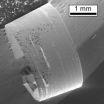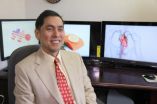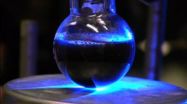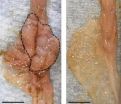(Press-News.org) LOS ALAMOS, N.M., March 3, 2014—What do some high-end golf clubs and your living room window have in common? The answer is glass, but in the golf clubs' case it's a specialized glass product, called metallic glass, with the ability to be bent considerably and spring back into its original form. Your windows, as you know, aren't quite as forgiving of a sudden impact, and they shatter – they are brittle, as opposed to ductile, or more flexible products. For the golf clubs, however, a new generation of flexible metallic glass puts more bounce back into a golf ball, from the metallic glass' high elasticity. They're not unbreakable, but close. And scientists are working toward even stronger and more elastic glass types which would fail in a ductile fashion instead of shattering.
"In glass, localized plastic deformation usually leads to immediate failure," said Seth Imhoff, a Los Alamos National Laboratory materials scientist. "Normally, metal alloys freeze into a collection of crystals in which the atoms line up into very specific patterns. In specially designed metal alloys an amorphous, or random atom arrangement, can be retained in the solid, which can allow us to tailor a wide range of properties such as the ability to be bent severely and spring back into place."
And for scientists, tweaking the shearing characteristics of materials such as glass has important applications well beyond the sporting world, it's a matter of broader impact, aiding such fields as space science, electrical transformers, cell phone cases, and yes, golf clubs, because their mechanical and magnetic properties are highly adjustable.
An international team of scientists from the University of Wisconsin-Madison, Los Alamos National Laboratory, Universitat Autònoma de Barcelona in Spain, and Tohoku University in Japan are hoping their discoveries will lead to glass that can be both stronger and more ductile.
The way that metallic glass deforms plastically is by the formation of what are called shear bands. Shear banding can occur on a macroscopic scale in granular materials, like during an avalanche or landslide, but in glass the bands are generally 10-20 nanometers wide (~3000 times thinner than a human hair!).
In their paper "Nucleation of Shear Bands in Amorphous Alloys" published this week in the Proceedings of the National Academy of Sciences, these researchers are looking at the initiation of shear-banding events in order to better understand how to control the mechanical properties of these materials.
Once a shear band is formed it travels very quickly across the material and can lead to failure. Therefore the strength is ultimately controlled by how and when they form; so shear banding is termed a "nucleation controlled event." The end goal is to understand this shear band nucleation, or initial formation, behavior so that better properties can be designed.
"We've used an experimental technique called nanoindentation to repeatedly sample the initial formation of shear bands," said Imhoff. "Nanoindentation essentially uses a tiny needle with a very precise shape to push on the surface of a sample in a very controlled way. Even though the force is very small, the tiny tip of the needle concentrates the stress in a very small region until a single shear band is generated in order to relieve some of that stress."
By repeating this process many times scientists sample many local atomic arrangements and their specific critical stress levels. The new experimental evidence provided in this work challenges the current assumption of only a single type of initiation site, or STZ (shear transformation zone).
Identification of multiple types of STZs could lead to new opportunities for controlling the strength and ductility of bulk metallic glasses… oh, and of course this means more durable high-performance golf clubs.
INFORMATION:
Funding: Research funded in part by the National Science Foundation (DMR-1005334) and Office of Naval Research (N00014-12-1-0569). Additional funding from Grants-in-Aid-S, Global COE for Materials Science, and World Premier International Research Center Initiative for Atoms, Molecules and Materials, the Ministry of Education, Culture, Sports and Science, Japan.
Photo caption: A piece of metallic glass that has been bent around onto itself with a 1mm radius and glued into place. It would spring back to a flat piece if the glue were removed. Photo, Los Alamos National Laboratory.
About Los Alamos National Laboratory
Los Alamos National Laboratory, a multidisciplinary research institution engaged in strategic science on behalf of national security, is operated by Los Alamos National Security, LLC, a team composed of Bechtel National, the University of California, The Babcock & Wilcox Company and URS Corporation for the Department of Energy's National Nuclear Security Administration.
Los Alamos enhances national security by ensuring the safety and reliability of the U.S. nuclear stockpile, developing technologies to reduce threats from weapons of mass destruction, and solving problems related to energy, environment, infrastructure, health and global security concerns.
'Fore!' heads up, wide use of more flexible metallic glass coming your way
Advances in glass alloys lead to strength, flexibility
2014-03-04
ELSE PRESS RELEASES FROM THIS DATE:
Black hawks downed: Study reveals bird threat to US military helicopters
2014-03-04
Rotary-wing aircraft, such as Apache and Chinook helicopters, play vital combat and logistical roles across the U.S. military services, but new research in the Wildlife Society Bulletin reveals how vulnerable these aircraft are to wildlife strikes.
Many types of aircraft are vulnerable to strikes, estimated to cost the aviation industry $1.2 billion worldwide per year; however, to date no assessment of strikes to military rotary-wing aircraft has been conducted.
A research team led by Dr. Brian Washburn from the Wildlife Research Center used records from the Army, Navy, ...
Blocking immune signaling stalls inflammation and insulin resistance tied to obesity
2014-03-04
Researchers at NYU Langone Medical Center have found that blocking the action of a key signaling molecule in the immune system known as Netrin-1 stalls chronic inflammation and insulin resistance tied to obesity and often derived from fatty diets.
Reporting in this week's issue of Nature Medicine, the NYU Langone team showed in experiments in mice and human tissue that Netrin-1 signaling is propelled by fat tissue growth. The team previously discovered that Netrin-1 was secreted by the immune system clean-up cells, or macrophages, whose buildup leads to inflammation. ...
High consumption of fish oil may benefit cardiovascular health, Pitt public health finds
2014-03-04
PITTSBURGH, March 4, 2014 – Eating fish in amounts comparable to those of people living in Japan seems to impart a protective factor that wards off heart disease, according to an international study funded by the National Institutes of Health (NIH) and led by the University of Pittsburgh Graduate School of Public Health.
Middle-aged Japanese men living in Japan had lower incidence of coronary artery calcification, a predictor of heart disease, than middle-aged white men living in the United States, likely due to the significantly higher consumption of omega-3 fatty acids ...
Long-term study confirms success of method for detecting spread of deadly skin cancer
2014-03-04
Research at UCLA on a technique for detecting the earliest spread of melanoma, the deadliest form of skin cancer, has confirmed that the procedure significantly prolongs patients' survival rates compared with traditional "watch and wait" techniques.
The technique, which combines lymphatic mapping and sentinel-node biopsy, allows doctors to quickly determine whether the disease has spread, or metastasized, to the lymph nodes, which occurs in approximately 20 percent of patients. Patients with cancer in their lymph nodes may benefit from having their other nearby lymph ...
Light zaps viruses: How photosensitization can stop viruses from infecting cells
2014-03-04
A UCLA-led team of researchers has found evidence that photosensitizing a virus's membrane covering can inhibit its ability to enter cells and potentially lead to the development of stronger, cheaper medications to fight a host of tough viruses.
The UCLA AIDS Institute study, published in the February issue of the Journal of Virology, is part of ongoing research on a compound called LJ001, a "broad-spectrum" antiviral that can attack a wide range of microbes.
The current paper advances the science by showing that the process of photosensitization — heightening a ...
A highly sensitive small molecule probe to evaluate potential risk for Parkinson's disease
2014-03-04
A team of researchers from National University of Singapore (NUS) have created the first two-photon, small molecule fluorogenic probe that can serve as a useful tool for the rapid assessment of an individual's potential risk for Parkinson's disease. The highly sensitive fluorescence probe can detect with high precision the activity of Monoamine Oxidase B (MAO-B), an enzyme that is found in elevated levels in patients with Parkinson's disease. This innovation paves the way for the development of less costly non-invasive technologies and devices to help monitor the risk and ...
Immune system-based therapy produces lasting remissions in melanoma patients
2014-03-04
BOSTON – A drug that unleashes the immune system to attack cancer can produce lasting remissions and hold the disease in check – for more than two years, in some cases – in many patients with advanced melanoma, according to a new study by researchers at Dana-Farber Cancer Institute, Johns Hopkins University, Yale University, and allied institutions.
The study, published online today, March 3, by the Journal of Clinical Oncology, provides the longest-term look so far at how melanoma patients have fared since receiving the drug, nivolumab, in a phase I clinical trial. The ...
Every step you take
2014-03-04
Artificial photosynthesis, in which we emulate the process used by nature to capture energy from the sun and convert it into electrochemical energy, is expected to be a major asset in any sustainable energy portfolio for the future. Artificial photosynthesis offers the promise of producing liquid fuels that are renewable and can be used without exacerbating global climate change. A key to realizing commercial-scale artificial photosynthesis technology is the development of electrocatalysts that can efficiently and economically carry out water oxidation reaction that is ...
Eliminating bacteria, changing lifestyle could lower risk in people genetically susceptible to color
2014-03-04
New York, NY— Bacteria in the gut are essential for the development of intestinal tumors in mice, according to research led by investigators from the Icahn School of Medicine at Mount Sinai. Removing the bacteria may play a critical role in reducing cancer risk, the researchers write, in the March issue of the Journal of Experimental Medicine.
Sergio A. Lira, MD, PhD, Director of the Immunology Institute, and Professor of Immunology and Medicine, and his laboratory at the Icahn School of Medicine at Mount Sinai, used a transgenic mouse model to test the hypothesis that ...
Voters using smartphones made fewer errors in mock election
2014-03-04
Voters who cast their ballots via smartphones made fewer errors than they did when voting via traditional methods in a mock election, according to new research from psychologists at Rice University.
In a first-of-its-kind study, co-author Rice Professor of Psychology Michael Byrne examined how smartphone-based voting systems can be incorporated into the current large-scale voting process. The study, "Toward More Usable Electronic Voting: Testing the Usability of a Smartphone Voting System," found that while there are no consistent differences in efficiency and perceived ...
LAST 30 PRESS RELEASES:
Norbert Holtkamp appointed director of Fermi National Accelerator Laboratory
New agentic AI platform accelerates advanced optics design
Biologists discover neurons use physical signals — not electricity — to stabilize communication
Researchers discover that a hormone can access the brain by hitchhiking
University of Oklahoma researcher awarded funding to pursue AI-powered material design
Exploring how the visual system recovers following injury
Support for parents with infants at pediatric check-ups leads to better reading and math skills in elementary school
Kids’ behavioral health is a growing share of family health costs
Day & night: Cancer disrupts the brain’s natural rhythm
COVID-19 vaccination significantly reduces risk to pregnant women and baby
The role of vaccination in maternal and perinatal outcomes associated with COVID-19 in pregnancy
Mayo Clinic smartwatch system helps parents shorten and defuse children's severe tantrums early
Behavioral health spending spikes to 40% of all children’s health expenditures, nearly doubling in a decade
Digital cognitive behavioral treatment for generalized anxiety disorder
Expenditures for pediatric behavioral health care over time and estimated family financial burden
Air conditioning in nursing homes and mortality during extreme heat
The Alps to lose a record number of glaciers in the next decade
What makes a good proton conductor?
New science reporting guide published for journalists in Bulgaria
New international study reveals major survival gaps among children with cancer
New science reporting guide published for journalists in Turkey
Scientists develop a smarter mRNA therapy that knows which cells to target
Neuroanatomy-informed brain–machine hybrid intelligence for robust acoustic target detection
Eight SwRI hydrogen projects funded by ENERGYWERX
The Lundquist Institute and its start-up company Vitalex Biosciences Announces Strategic Advancement of Second-Generation fungal Vaccine VXV-01 through Phase 1 Trials under $40 Million Competitive Con
Fine particles in pollution are associated with early signs of autoimmune disease
Review article | Towards a Global Ground-Based Earth Observatory (GGBEO): Leveraging existing systems and networks
Penn and UMich create world’s smallest programmable, autonomous robots
Cleveland researchers launch first major study to address ‘hidden performance killer’ in athletes
To connect across politics, try saying what you oppose
[Press-News.org] 'Fore!' heads up, wide use of more flexible metallic glass coming your wayAdvances in glass alloys lead to strength, flexibility



